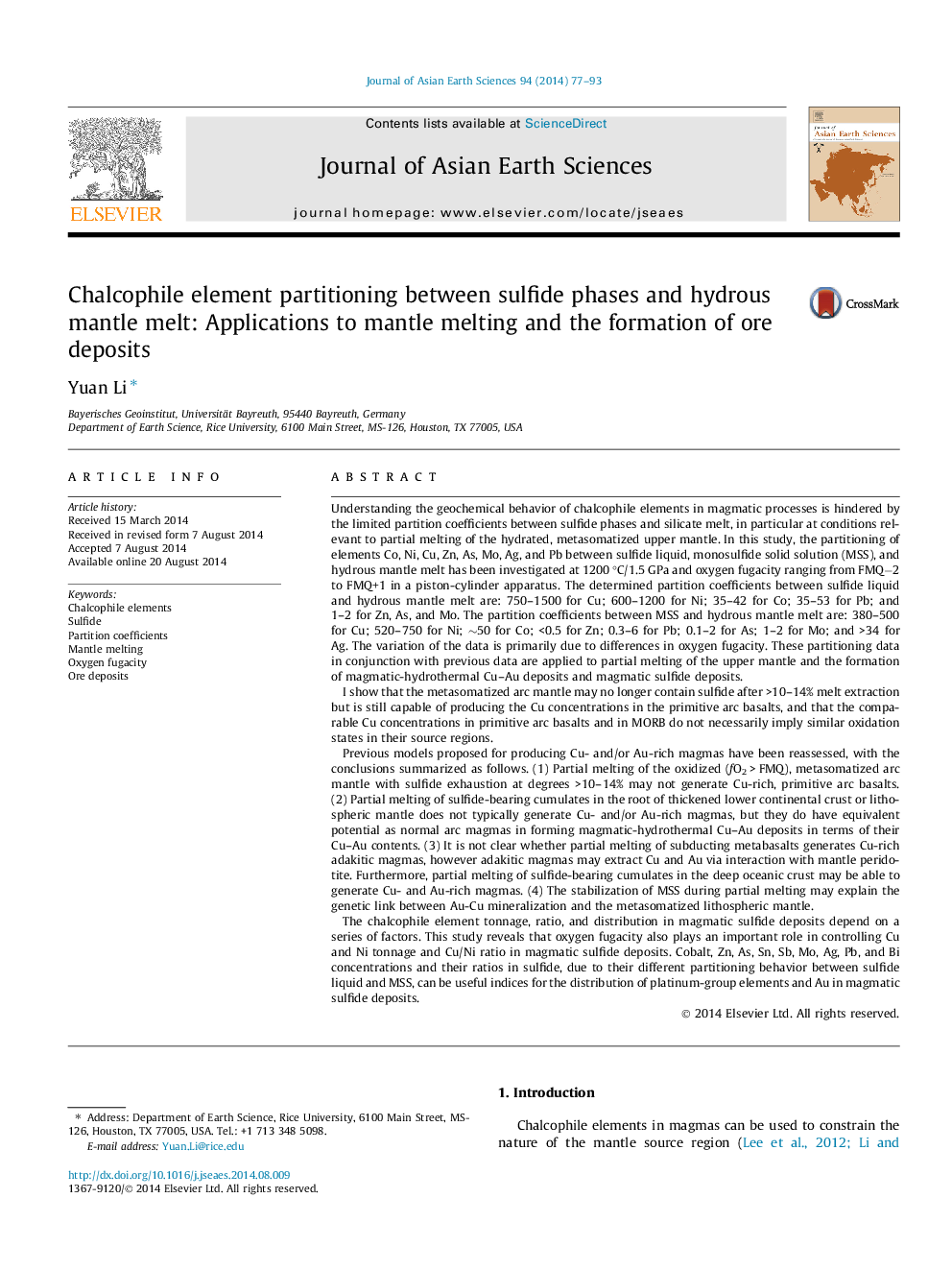| کد مقاله | کد نشریه | سال انتشار | مقاله انگلیسی | نسخه تمام متن |
|---|---|---|---|---|
| 4730582 | 1640374 | 2014 | 17 صفحه PDF | دانلود رایگان |
• Partitioning data between sulfide phases and hydrous mantle melts.
• Model Cu geochemical behavior during mantle melting.
• Models for generating Cu-and/or Au-rich magmas.
• fO2 is one factor controlling Cu, Ni tonnage and ratio in magmatic sulfide deposit.
Understanding the geochemical behavior of chalcophile elements in magmatic processes is hindered by the limited partition coefficients between sulfide phases and silicate melt, in particular at conditions relevant to partial melting of the hydrated, metasomatized upper mantle. In this study, the partitioning of elements Co, Ni, Cu, Zn, As, Mo, Ag, and Pb between sulfide liquid, monosulfide solid solution (MSS), and hydrous mantle melt has been investigated at 1200 °C/1.5 GPa and oxygen fugacity ranging from FMQ−2 to FMQ+1 in a piston-cylinder apparatus. The determined partition coefficients between sulfide liquid and hydrous mantle melt are: 750–1500 for Cu; 600–1200 for Ni; 35–42 for Co; 35–53 for Pb; and 1–2 for Zn, As, and Mo. The partition coefficients between MSS and hydrous mantle melt are: 380–500 for Cu; 520–750 for Ni; ∼50 for Co; <0.5 for Zn; 0.3–6 for Pb; 0.1–2 for As; 1–2 for Mo; and >34 for Ag. The variation of the data is primarily due to differences in oxygen fugacity. These partitioning data in conjunction with previous data are applied to partial melting of the upper mantle and the formation of magmatic-hydrothermal Cu–Au deposits and magmatic sulfide deposits.I show that the metasomatized arc mantle may no longer contain sulfide after >10–14% melt extraction but is still capable of producing the Cu concentrations in the primitive arc basalts, and that the comparable Cu concentrations in primitive arc basalts and in MORB do not necessarily imply similar oxidation states in their source regions.Previous models proposed for producing Cu- and/or Au-rich magmas have been reassessed, with the conclusions summarized as follows. (1) Partial melting of the oxidized (fO2 > FMQ), metasomatized arc mantle with sulfide exhaustion at degrees >10–14% may not generate Cu-rich, primitive arc basalts. (2) Partial melting of sulfide-bearing cumulates in the root of thickened lower continental crust or lithospheric mantle does not typically generate Cu- and/or Au-rich magmas, but they do have equivalent potential as normal arc magmas in forming magmatic-hydrothermal Cu–Au deposits in terms of their Cu–Au contents. (3) It is not clear whether partial melting of subducting metabasalts generates Cu-rich adakitic magmas, however adakitic magmas may extract Cu and Au via interaction with mantle peridotite. Furthermore, partial melting of sulfide-bearing cumulates in the deep oceanic crust may be able to generate Cu- and Au-rich magmas. (4) The stabilization of MSS during partial melting may explain the genetic link between Au-Cu mineralization and the metasomatized lithospheric mantle.The chalcophile element tonnage, ratio, and distribution in magmatic sulfide deposits depend on a series of factors. This study reveals that oxygen fugacity also plays an important role in controlling Cu and Ni tonnage and Cu/Ni ratio in magmatic sulfide deposits. Cobalt, Zn, As, Sn, Sb, Mo, Ag, Pb, and Bi concentrations and their ratios in sulfide, due to their different partitioning behavior between sulfide liquid and MSS, can be useful indices for the distribution of platinum-group elements and Au in magmatic sulfide deposits.
Journal: Journal of Asian Earth Sciences - Volume 94, November 2014, Pages 77–93
